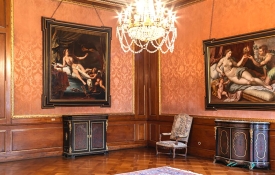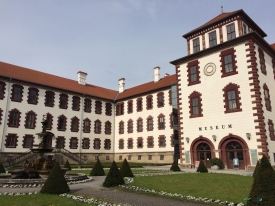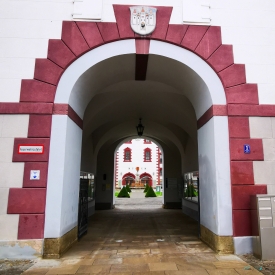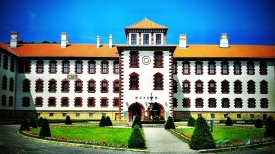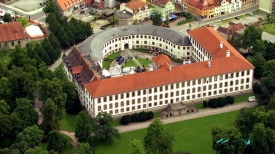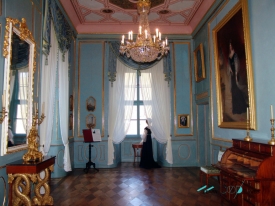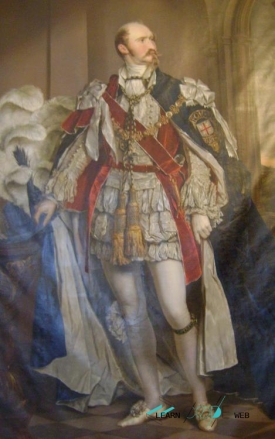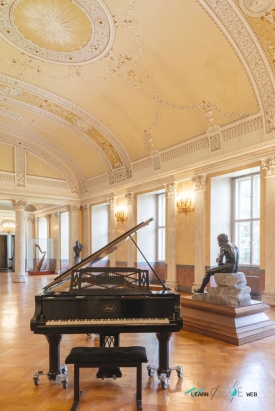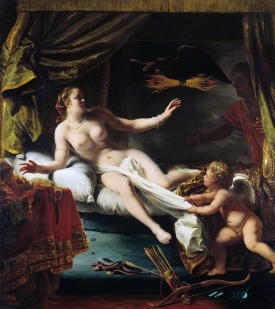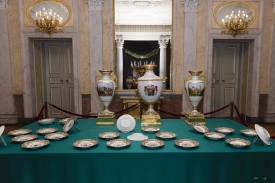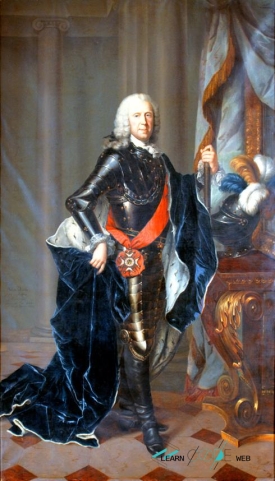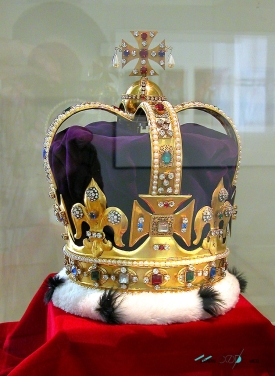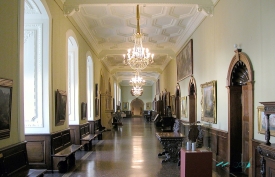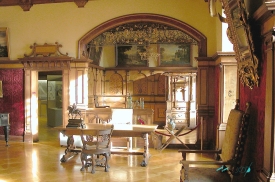The Meiningen Museums unite six cultural history museums in the district town of Meiningen. They are the largest museum in southern Thuringia and house the most extensive art collection in Thuringia. The main part with four departments is located in Elisabethenburg Castle, the former residence of the Dukes of Saxe-Meiningen. The castle is located in the west of the historic old town on the Werra. The Meiningen museums belong to the Meiningen-Eisenach Cultural Foundation, which is supported by the Free State of Thuringia, the city of Meiningen and the district of Schmalkalden-Meiningen.
The Meiningen Museums were founded on May 24, 1947 with the merger of the art collections in Elisabethenburg Castle and the Baumbachhaus. The basis was created by the historic interior of the ducal buildings, which was accessible from 1918, and the collections of the Hennebergisch Antiquities Research Association founded by Ludwig Bechstein in 1832, which was renamed the Hennebergisch-Franconian Historical Association in 1935.
After the Second World War, the Soviet military administration confiscated large parts of the property of the ducal house of Saxe-Meiningen, such as the ducal library, furniture and armaments, and transported them to the Soviet Union. After the museums opened in 1947, the collections in the fields of art, music, theater and the history of the city grew rapidly. The holdings were initially looked after by freelancers, including Minna Lang. The first full-time director from 1950 was Irmgard Suffrian-Engelke.
From 1957 to 1982 there was a bird show belonging to the museum in the Minna-Lang log cabin in a one-hectare bird sanctuary on the Bibrasberg in Meiningen. About 200 bird specimens and other exhibits were on display there and interesting facts about the world of birds were conveyed.
From 1960, the city of Meiningen was the legal entity for the museums and the aim was to set up a historical research institute alongside the museum. From 1964 to 1990, the Suhl district council was responsible for the museums, which were known as the "Meiningen State Museums" during this time. The Meiningen museums had around 60 employees at the time. In the 1980s, the museums in the GDR were realigned by They specialized in certain exhibition themes. The Meiningen museums thus took over numerous art objects from other museums and gave them to correspondingly specialized museums that did not belong to the art spectrum. After conversion and restoration, the Baumbachhaus was reopened in 1982 as a literature museum and writers' center.
After the political change in 1989/90, the Free State of Thuringia took over the Meiningen Museums. Since the founding of the Meiningen Cultural Foundation in 1997, the Free State has held 80% and the city of Meiningen and the district have each held 10% of the sponsorship. In the years after the reunification, museums had to hand over numerous objects through restitution to private individuals who were entitled to claim them. An amicable agreement was reached with the ducal house of Saxony-Meiningen in 2004.
On May 21, 2000, the opening of the new theater museum "Magic World of Scenery" took place, where, among other things, historical stage sets are presented in changing permanent exhibitions. On November 1, 2021, the lawyer and musicologist Philipp Adlung succeeded the director Winfried, who retired at the end of October 2021 Wiegand.New future plans for the Meiningen museums envisage greater relevance for all of Thuringia, greater digitization, redesigned tours and more regional history, especially Meiningen and Henneberg history.
The Meiningen Museums were founded on May 24, 1947 with the merger of the art collections in Elisabethenburg Castle and the Baumbachhaus. The basis was created by the historic interior of the ducal buildings, which was accessible from 1918, and the collections of the Hennebergisch Antiquities Research Association founded by Ludwig Bechstein in 1832, which was renamed the Hennebergisch-Franconian Historical Association in 1935.
After the Second World War, the Soviet military administration confiscated large parts of the property of the ducal house of Saxe-Meiningen, such as the ducal library, furniture and armaments, and transported them to the Soviet Union. After the museums opened in 1947, the collections in the fields of art, music, theater and the history of the city grew rapidly. The holdings were initially looked after by freelancers, including Minna Lang. The first full-time director from 1950 was Irmgard Suffrian-Engelke.
From 1957 to 1982 there was a bird show belonging to the museum in the Minna-Lang log cabin in a one-hectare bird sanctuary on the Bibrasberg in Meiningen. About 200 bird specimens and other exhibits were on display there and interesting facts about the world of birds were conveyed.
From 1960, the city of Meiningen was the legal entity for the museums and the aim was to set up a historical research institute alongside the museum. From 1964 to 1990, the Suhl district council was responsible for the museums, which were known as the "Meiningen State Museums" during this time. The Meiningen museums had around 60 employees at the time. In the 1980s, the museums in the GDR were realigned by They specialized in certain exhibition themes. The Meiningen museums thus took over numerous art objects from other museums and gave them to correspondingly specialized museums that did not belong to the art spectrum. After conversion and restoration, the Baumbachhaus was reopened in 1982 as a literature museum and writers' center.
After the political change in 1989/90, the Free State of Thuringia took over the Meiningen Museums. Since the founding of the Meiningen Cultural Foundation in 1997, the Free State has held 80% and the city of Meiningen and the district have each held 10% of the sponsorship. In the years after the reunification, museums had to hand over numerous objects through restitution to private individuals who were entitled to claim them. An amicable agreement was reached with the ducal house of Saxony-Meiningen in 2004.
On May 21, 2000, the opening of the new theater museum "Magic World of Scenery" took place, where, among other things, historical stage sets are presented in changing permanent exhibitions. On November 1, 2021, the lawyer and musicologist Philipp Adlung succeeded the director Winfried, who retired at the end of October 2021 Wiegand.New future plans for the Meiningen museums envisage greater relevance for all of Thuringia, greater digitization, redesigned tours and more regional history, especially Meiningen and Henneberg history.



